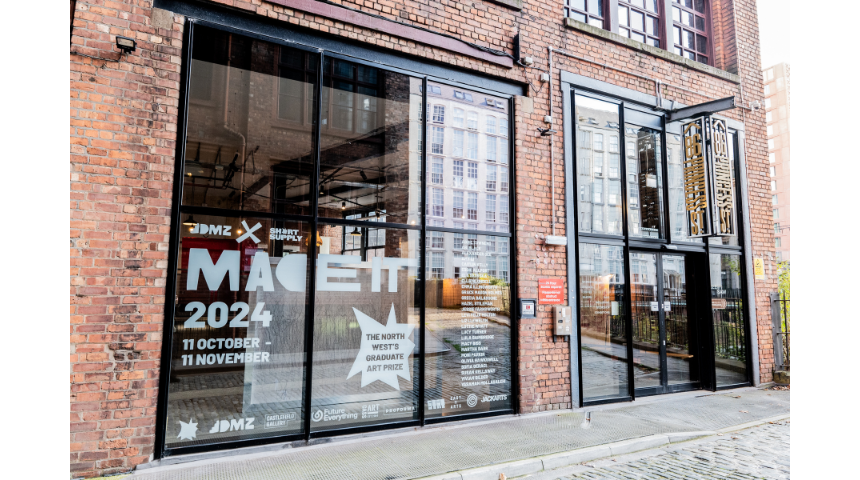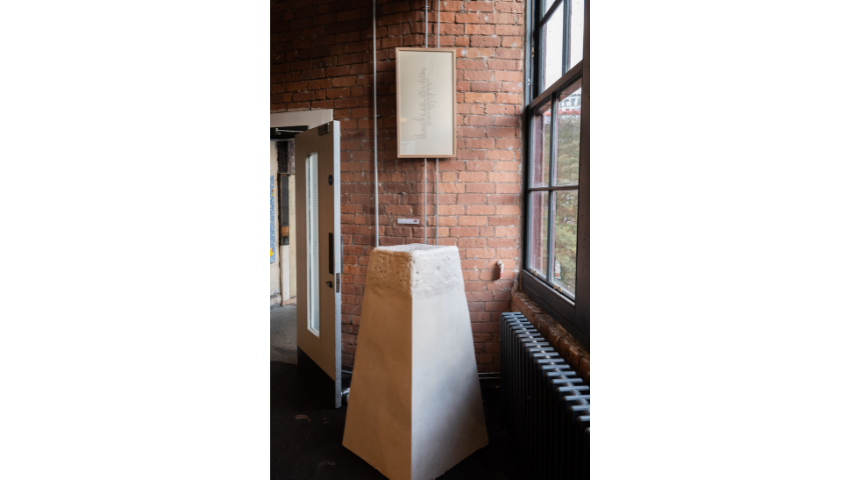FROM THE ARTIST’S MOUTH Nov 2024 MADE IT 2024: From the outside looking in
Rowan Pritchard
Exterior view MADE IT 2024 at SEESAW Gallery. Courtesy of DMZ. Photo: Conor Muir-Cochran.
the Fourdrinier is an online journal dedicated to contemporary artists, exhibitions and visual art projects, with a focus on the North West. As part of our remit, we’ve always sought to give coverage to independent, artist-led and not-for-profit spaces, and individual artists. With this in mind, we are opening up a pre-existing section on our site, ‘From the Artist’s Mouth’ to allow one artist or artist group per month/issue to submit a text of their own wording (whether descriptive, critical, or experimental – subject to editorial). Please see the ‘About’ page and/or email thefourdrinier@gmail.com for more information on ‘From the Artist’s Mouth.’
Rowan Pritchard is an artist, curator, and wearer of many hats. Based in Greater Manchester (though currently travelling elsewhere), their various practices centre on queerness, community, collectivity, and radical sustainability. Their art practice encompasses queer tactics of collage, photography, digital media, quilting, and recently chainmaille. As a member of DMZ, alongside Ruby Ferguson, Charlotte Holt, Kay Shah and Bobbie Wilson, Pritchard was selected to produce this year’s MADE IT, established by Short Supply in 2019 and reflects here on their experience of mentoring a group of MADE IT 2024 participants.
One of the gorgeous things about mentorship is getting to know artists. Getting to know who they are, and why they make the work they do. And one of the challenges of curating and presenting an artist’s work is knowing how much to reveal, what to explain, and when.
When I suggested to the other members of DMZ, the curatorial team behind this year’s MADE IT graduate art prize, that we should each mentor a small group of the selected artists, I did not think about the difficult task I was also inevitably setting myself.
From a small but alarmingly trendy coffee shop in Lisbon, I first log on to Zoom to meet my group. Abi Black, Grecia Balassone, Sofia Geraci, Emma Illingworth and Liz Llewelyn. I am in the unusual position of being away from the North West while working on the North West Graduate Art Prize. Yet this alternative perspective seems fitting as each artist introduces their practice. Kissing gates, Morris dancing, tower blocks, fridge magnets, family, memory, touch, place, belonging… strings of connection begin to weave throughout the conversation. Moments of harmony singing across pixelated split screens.
Describing their work, each artist has been through a process of careful excavation. Their sites range from their family histories to the physical and digital landscapes and archives they inhabit. Across the works, which themselves span the breadth of media from video and installation to traditional craft practices, they share a perspective that feels slightly removed - somehow defamiliarised. We discuss this act of recontextualising and reframing.
As Abi Black describes their family archives, hidden away in boxes under the stairs, I nod, thinking of my own archives, currently in storage thousands of miles away. Her work explores the structure of place, creating a visual language drawn from their everyday surroundings. On relocating as a student from Rochdale to the city centre of Manchester, she revisits her archives, literally reframing them to reconsider their importance.
Abi Black Untitled 1 - Lanky Town (2023) installation shot. Digitally printed fabric on lampshade 600 mm x 450 mm x 450 mm. Courtesy of DMZ. Photo: Charlotte Holt.
Now at SEESAW, landscapes of Rochdale are illuminated on lampshades. Moments from their mother’s upbringing are recreated, celebrated, and framed on gallery walls. Wallets hung in presentation trays, rather than slung in boxes, serve as signifiers of how these objects become part of us. Our history shapes how we view and move through the world. Black’s careful compositions question which objects are considered valuable, whose histories are preserved, and why that is.
Sofia Geraci also meditates on the domestic objects that tie themselves to our sense and formation of self. Like me, Geraci is no longer in Manchester while we try to negotiate compatible times to meet and discuss her work. She is in Venice representing John Akomfrah’s work at the Biennale with the British Council. It feels fitting that she is in Italy as we discuss her work.
Through sound and ceramics, Geraci invites us to join her in an echo of a Sicilian kitchen. The scattering of magnets, photographs, and handmade terracotta tiles - neither full wall nor floor - are instead collaged across both. Like a dream of a place where only the objects in focus are real. A hazy memory. The gaps feel pertinent.
Sofia Geraci Feeding Through Memory (2024) (detail) installation. Courtesy of DMZ. Photo: Conor Muir-Cochran.
Her work gives presence to the migratory space between London and Sicily where she was raised, and the dissonances that being from two places, yet not fully belonging anywhere creates. But there is something tender about the space Geraci has created, a space rooted in care. It’s maternal and proud. It feels like being let in on a secret. Like a family recipe passed down through generations.
The relationship between people and place is a force throughout the five artists’ work and something I explore in my own practice. Desire lines, beating the bounds, how borders and boundaries are shaped, and how they shape us. As a queer teenager living on the rural Welsh border, these are questions and ideas that underpinned much of my early adulthood and my own undergraduate work.
a2 + b2 = c2 (2024) stands as a monument to these questions, thoughts, and ideas. An exact replica of Pendle Hill Trig Point, Liz Llewelyn preserves the invisible traces of the human relationship with place. Each fingerprint to touch the trig point in a single day is captured in clay and revealed in plaster.
Liz Llewelyn a2 + b2 = c2 (2024) installation shot. Plaster, hessian, clay water 1200 mm x 500mm x 500mm. Courtesy of DMZ. Photo: Conor Muir-Cochran.
Across Llewelyn’s work, moments of concealed touch are revealed. The kiss over a kissing gate whittled into wood - memorialising an otherwise fleeting act. A similar technique is used again in Sit With Me (2024), a collaborative piece with Lula Bainbridge, on display as part of MADE IT, which reveals the hidden ‘seat’ within a tree stump stool. Llewelyn’s work is strikingly simple, standing quietly confident, yet saying so much. It is a visual rendering of our connection to the past and our influence on the future. A reminder that our touch and presence have power and impact, even when they can’t be seen.
One of the things that is so evident in the work of each of these emerging artists is the importance of imagery. Each body of work speaks in a visual language shaped by each artist’s own experiences. Perhaps it is the prevalence of digital media that permeates their personal post-Y2K childhoods. We have all become accustomed to curating our own digital avatars and the virtual landscapes in which they live.
It is evident, particularly from Emma Illingworth, that she enjoyed an upbringing split across both physical and digital playgrounds. In her work, Illingworth does not draw from the physical and ancestral locations of her personal history but instead looks to the myths and legends of the internet. Illingworth speaks to those slippery digital spaces where I too came of age and formed my cultural almanac. I am reminded of late nights on Omegle, endless scrolling on Tumblr and plundering the depths of early YouTube.
Number 1 in the Funeral Music Charts (2024) brings a piece of this internet mythology – the so-called ‘My Way’ Killings – into the gallery. She creates a space where we are each invited to extend the myth, add our own warblings to the cacophony of pixelated performers, and contemplate what it means to ‘live on’ – to cheat death in a hauntingly 21st Century way.
Emma Illingworth Number 1 in the Funeral Music Charts (2024) still from found footage and text, 40 minutes. Courtesy of the artist.
I first encountered Grecia Balassone’s work at the University of Salford Degree Show earlier this year. I was immediately drawn to Balassone’s clogs. There is something irresistible about a clog, perhaps reflected in their near universality and timelessness, from the ancient Chinese jī to the Croc today.
There is a beautiful contrast in the way Balassone’s work is presented at SEESAW. The smooth aluminium armature of Alex Gee’s work installed alongside Eddie Allport’s audaciously inflated notebook pages become the backdrop to Balassone’s Research Quilt (2024). The quilt is personal, reflected in its handcrafted quality, exploring Balassone’s journey to connect with the community encompassing the endangered craft of clog making. Having moved to the UK in 2019 from Venezuela, Balassone uses clogs and their links to British culture and heritage as a way to connect to their own new-found home. The quilt, a comfort object, adorned with moments and memories from across their deep dive into this craft and community, celebrates the sense of home, safety, and connection that can be found in objects.
Live performance accompanying Grecia Balassone’s Research Quilt (2024) & Clogs (2023) Courtesy of DMZ. Photo: Conor Muir-Cochran.
Across all of the work, there is a question of connection and belonging. A search that feels painfully universal. As I meet with the artists across continents and time zones, I am struck by how well each of them captures the distinct feeling of searching for the place where you belong: where you are recognised. From familiar objects that can transport us across time and memory, to intangible moments and sites of connection, the artists create space to celebrate and to be seen across the floors of SEESAW. Whether it’s under the disco lights singing karaoke with virtual strangers, or surrounded by familiar objects from the homes of our families, across our landscapes and histories the artists create moments where we can each belong and live on within. Archives are brought to life, revitalised, and added to.
This text serves as an act of archiving of its own, and my answer to the question of how much of the creative and curatorial process to share. While I have worked from the outskirts of MADE IT 2024, I have been able to connect with, and also view the process in a way that feels particularly poignant and prescient to the work of the five artists I have been so fortunate to connect with. I am reminded that what makes our perspectives as artists, curators, and people unique and valuable is the different references, backgrounds, and histories we draw upon. And in those moments and spaces where we can recognise each other, despite differences and distance, we build the places of belonging that our work searches for.
When DMZ first contemplated what our version of MADE IT 2024 might look like, we wanted to create not just a stonking exhibition of the best graduate work from across the North West, but to cultivate a community; a permanence of connection - rooted in a more personal experience.
When I see images from the exhibition for the first time, I am astounded by how distinctly vibrant, thoughtful, and generous it is. The nature of the exhibition speaks to the profuse and abundant community that has grown around this latest edition of MADE IT. Bringing together creatives, finding the connections and points of synergy, and creating a culture in which we can share, inspire, and support each other.






